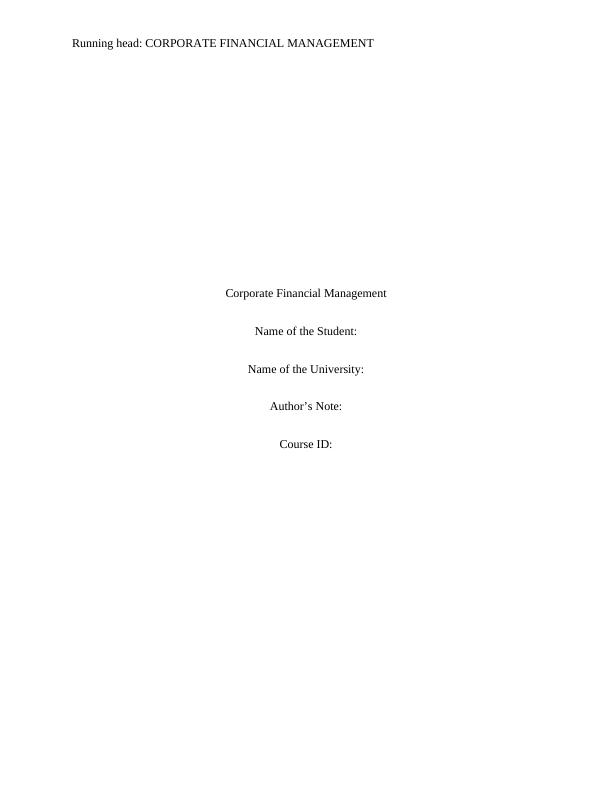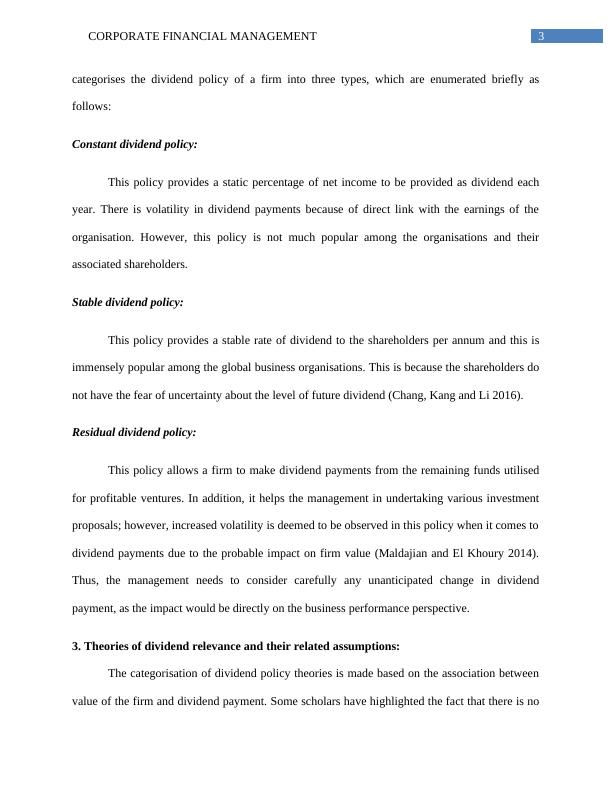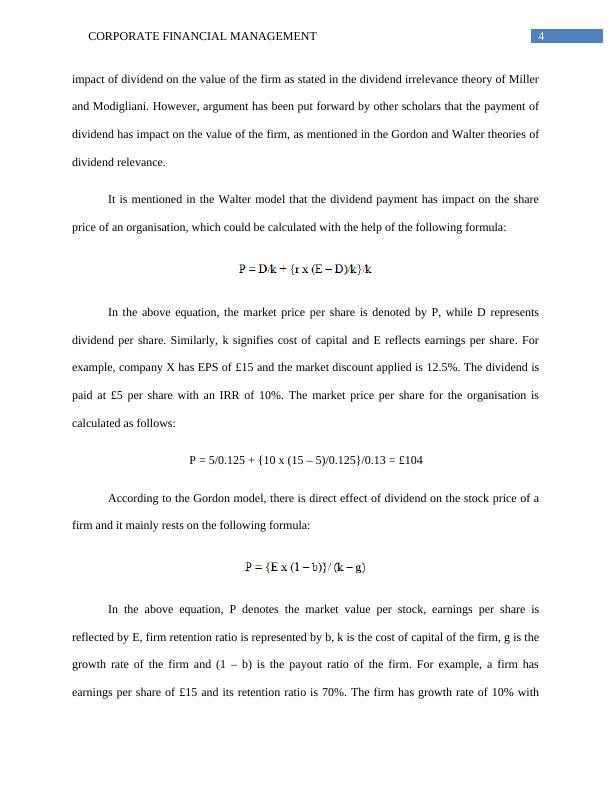Corporate Financial Management: Dividend Policy and Financial Analysis of Sainsbury Plc
Added on 2023-06-10
22 Pages4536 Words446 Views
Running head: CORPORATE FINANCIAL MANAGEMENT
Corporate Financial Management
Name of the Student:
Name of the University:
Author’s Note:
Course ID:
Corporate Financial Management
Name of the Student:
Name of the University:
Author’s Note:
Course ID:

1CORPORATE FINANCIAL MANAGEMENT
Table of Contents
Task A:.............................................................................................................................................2
1. Introduction:............................................................................................................................2
2. Dividend policy:......................................................................................................................2
3. Theories of dividend relevance and their related assumptions:...............................................3
4. Dividend irrelevance theory of Miller and Modigliani:..........................................................5
5. Comparison between dividend relevant and dividend irrelevant theories:..............................6
6. Conclusion:..............................................................................................................................7
Task B:.............................................................................................................................................7
Introduction:................................................................................................................................7
a. Current financial performance of Sainsbury Plc:.....................................................................7
b. Debt capacity (gearing level) of Sainsbury Plc:....................................................................12
c. Financial and business risks confronting Sainsbury Plc:.......................................................14
d. Recommendation of optimum capital mix for Sainsbury Plc:...............................................15
Conclusion:................................................................................................................................15
References:....................................................................................................................................16
Appendices:...................................................................................................................................19
Table of Contents
Task A:.............................................................................................................................................2
1. Introduction:............................................................................................................................2
2. Dividend policy:......................................................................................................................2
3. Theories of dividend relevance and their related assumptions:...............................................3
4. Dividend irrelevance theory of Miller and Modigliani:..........................................................5
5. Comparison between dividend relevant and dividend irrelevant theories:..............................6
6. Conclusion:..............................................................................................................................7
Task B:.............................................................................................................................................7
Introduction:................................................................................................................................7
a. Current financial performance of Sainsbury Plc:.....................................................................7
b. Debt capacity (gearing level) of Sainsbury Plc:....................................................................12
c. Financial and business risks confronting Sainsbury Plc:.......................................................14
d. Recommendation of optimum capital mix for Sainsbury Plc:...............................................15
Conclusion:................................................................................................................................15
References:....................................................................................................................................16
Appendices:...................................................................................................................................19

2CORPORATE FINANCIAL MANAGEMENT
Task A:
1. Introduction:
Capital need is critical to the success of any business organisation and five types of
capital are generally found in the same. These are manufactured capital, human capital, finance
capital, natural capital and social capital. In this section, emphasis would be placed on finance
capital only, which is divided further into debt capital and equity capital. The basic management
need is to maximise shareholder value as well as that of the owners (Vernimmen et al. 2014).
According to some analysts, the share price of an organisation helps in representing its business
value. Further argument has been made that the share price of the firm is dependent on dividend
payment and hence, based on logic, relation is present between firm value and payment of
dividend (Avanzi, Tu and Wong 2016).
In this segment, attempt is made so that meaningful insight could be obtained regarding
the dividend policy by analysis of the theories supported further by empirical findings. Another
aspect has been taken into account, which states that the analysts think that the firm value is
dependent on its dividend policy, as mentioned in dividend irrelevance theory.
2. Dividend policy:
Dividend policy is the guidelines that an organisation uses for ascertaining the portion of
profit to be provided to its shareholders as dividend. The board of directors of the organisation
declares the dividend percentage and after its determination, it is treated as debt that is not easy
to be withdrawn (Baker and Weigand 2015). The dividend policy is influenced due to a wide
variety of factors that include expectations of future earnings, legal duties, availability of
investment alternatives and liquidity position. The payment of dividend and its frequency further
Task A:
1. Introduction:
Capital need is critical to the success of any business organisation and five types of
capital are generally found in the same. These are manufactured capital, human capital, finance
capital, natural capital and social capital. In this section, emphasis would be placed on finance
capital only, which is divided further into debt capital and equity capital. The basic management
need is to maximise shareholder value as well as that of the owners (Vernimmen et al. 2014).
According to some analysts, the share price of an organisation helps in representing its business
value. Further argument has been made that the share price of the firm is dependent on dividend
payment and hence, based on logic, relation is present between firm value and payment of
dividend (Avanzi, Tu and Wong 2016).
In this segment, attempt is made so that meaningful insight could be obtained regarding
the dividend policy by analysis of the theories supported further by empirical findings. Another
aspect has been taken into account, which states that the analysts think that the firm value is
dependent on its dividend policy, as mentioned in dividend irrelevance theory.
2. Dividend policy:
Dividend policy is the guidelines that an organisation uses for ascertaining the portion of
profit to be provided to its shareholders as dividend. The board of directors of the organisation
declares the dividend percentage and after its determination, it is treated as debt that is not easy
to be withdrawn (Baker and Weigand 2015). The dividend policy is influenced due to a wide
variety of factors that include expectations of future earnings, legal duties, availability of
investment alternatives and liquidity position. The payment of dividend and its frequency further

3CORPORATE FINANCIAL MANAGEMENT
categorises the dividend policy of a firm into three types, which are enumerated briefly as
follows:
Constant dividend policy:
This policy provides a static percentage of net income to be provided as dividend each
year. There is volatility in dividend payments because of direct link with the earnings of the
organisation. However, this policy is not much popular among the organisations and their
associated shareholders.
Stable dividend policy:
This policy provides a stable rate of dividend to the shareholders per annum and this is
immensely popular among the global business organisations. This is because the shareholders do
not have the fear of uncertainty about the level of future dividend (Chang, Kang and Li 2016).
Residual dividend policy:
This policy allows a firm to make dividend payments from the remaining funds utilised
for profitable ventures. In addition, it helps the management in undertaking various investment
proposals; however, increased volatility is deemed to be observed in this policy when it comes to
dividend payments due to the probable impact on firm value (Maldajian and El Khoury 2014).
Thus, the management needs to consider carefully any unanticipated change in dividend
payment, as the impact would be directly on the business performance perspective.
3. Theories of dividend relevance and their related assumptions:
The categorisation of dividend policy theories is made based on the association between
value of the firm and dividend payment. Some scholars have highlighted the fact that there is no
categorises the dividend policy of a firm into three types, which are enumerated briefly as
follows:
Constant dividend policy:
This policy provides a static percentage of net income to be provided as dividend each
year. There is volatility in dividend payments because of direct link with the earnings of the
organisation. However, this policy is not much popular among the organisations and their
associated shareholders.
Stable dividend policy:
This policy provides a stable rate of dividend to the shareholders per annum and this is
immensely popular among the global business organisations. This is because the shareholders do
not have the fear of uncertainty about the level of future dividend (Chang, Kang and Li 2016).
Residual dividend policy:
This policy allows a firm to make dividend payments from the remaining funds utilised
for profitable ventures. In addition, it helps the management in undertaking various investment
proposals; however, increased volatility is deemed to be observed in this policy when it comes to
dividend payments due to the probable impact on firm value (Maldajian and El Khoury 2014).
Thus, the management needs to consider carefully any unanticipated change in dividend
payment, as the impact would be directly on the business performance perspective.
3. Theories of dividend relevance and their related assumptions:
The categorisation of dividend policy theories is made based on the association between
value of the firm and dividend payment. Some scholars have highlighted the fact that there is no

4CORPORATE FINANCIAL MANAGEMENT
impact of dividend on the value of the firm as stated in the dividend irrelevance theory of Miller
and Modigliani. However, argument has been put forward by other scholars that the payment of
dividend has impact on the value of the firm, as mentioned in the Gordon and Walter theories of
dividend relevance.
It is mentioned in the Walter model that the dividend payment has impact on the share
price of an organisation, which could be calculated with the help of the following formula:
In the above equation, the market price per share is denoted by P, while D represents
dividend per share. Similarly, k signifies cost of capital and E reflects earnings per share. For
example, company X has EPS of £15 and the market discount applied is 12.5%. The dividend is
paid at £5 per share with an IRR of 10%. The market price per share for the organisation is
calculated as follows:
P = 5/0.125 + {10 x (15 – 5)/0.125}/0.13 = £104
According to the Gordon model, there is direct effect of dividend on the stock price of a
firm and it mainly rests on the following formula:
In the above equation, P denotes the market value per stock, earnings per share is
reflected by E, firm retention ratio is represented by b, k is the cost of capital of the firm, g is the
growth rate of the firm and (1 – b) is the payout ratio of the firm. For example, a firm has
earnings per share of £15 and its retention ratio is 70%. The firm has growth rate of 10% with
impact of dividend on the value of the firm as stated in the dividend irrelevance theory of Miller
and Modigliani. However, argument has been put forward by other scholars that the payment of
dividend has impact on the value of the firm, as mentioned in the Gordon and Walter theories of
dividend relevance.
It is mentioned in the Walter model that the dividend payment has impact on the share
price of an organisation, which could be calculated with the help of the following formula:
In the above equation, the market price per share is denoted by P, while D represents
dividend per share. Similarly, k signifies cost of capital and E reflects earnings per share. For
example, company X has EPS of £15 and the market discount applied is 12.5%. The dividend is
paid at £5 per share with an IRR of 10%. The market price per share for the organisation is
calculated as follows:
P = 5/0.125 + {10 x (15 – 5)/0.125}/0.13 = £104
According to the Gordon model, there is direct effect of dividend on the stock price of a
firm and it mainly rests on the following formula:
In the above equation, P denotes the market value per stock, earnings per share is
reflected by E, firm retention ratio is represented by b, k is the cost of capital of the firm, g is the
growth rate of the firm and (1 – b) is the payout ratio of the firm. For example, a firm has
earnings per share of £15 and its retention ratio is 70%. The firm has growth rate of 10% with

5CORPORATE FINANCIAL MANAGEMENT
12% cost of capital. The market value per stock could be computed with the help of the above-
stated formula:
P = {15 x (1 – 0.70)}/ (12 – 10) = £225
4. Dividend irrelevance theory of Miller and Modigliani:
Before the establishment of this theory by Miller and Modigliani, there uses to be a
common notion that as the dividend payout of an organisation increases, there is an increase in
its enterprise value as well. However, this theory has been formulated for contradicting the
common notion and it states that the enterprise value does not increase or decrease with rise or
fall in dividend payment (Ahmed 2015). This theory states that the enterprise value varies based
on the ability of an organisation towards risk acceptance and revenue generating capacity. Thus,
this theory assumed certain stuffs, which are highlighted as follows:
Capital markets are completely perfect
There is no presence of corporate tax
There is absence of transaction or floatation cost
The investment policy is basically fixed in nature
According to this theory, if a company focuses on retained profits instead of distributing net
income in the form of dividend, it is possible that the shareholders might be able to enjoy capital
appreciation identical to retained earnings. However, if net income is distributed in the form of
dividend, the stockholders would obtain dividend identical to the sacrificed capital appreciation
(Fairchild, Guney and Thanatawee 2014). Based on this theory, an inference could be drawn that
the division of earnings between dividend and retained earnings has no effect on value of the
organisation.
12% cost of capital. The market value per stock could be computed with the help of the above-
stated formula:
P = {15 x (1 – 0.70)}/ (12 – 10) = £225
4. Dividend irrelevance theory of Miller and Modigliani:
Before the establishment of this theory by Miller and Modigliani, there uses to be a
common notion that as the dividend payout of an organisation increases, there is an increase in
its enterprise value as well. However, this theory has been formulated for contradicting the
common notion and it states that the enterprise value does not increase or decrease with rise or
fall in dividend payment (Ahmed 2015). This theory states that the enterprise value varies based
on the ability of an organisation towards risk acceptance and revenue generating capacity. Thus,
this theory assumed certain stuffs, which are highlighted as follows:
Capital markets are completely perfect
There is no presence of corporate tax
There is absence of transaction or floatation cost
The investment policy is basically fixed in nature
According to this theory, if a company focuses on retained profits instead of distributing net
income in the form of dividend, it is possible that the shareholders might be able to enjoy capital
appreciation identical to retained earnings. However, if net income is distributed in the form of
dividend, the stockholders would obtain dividend identical to the sacrificed capital appreciation
(Fairchild, Guney and Thanatawee 2014). Based on this theory, an inference could be drawn that
the division of earnings between dividend and retained earnings has no effect on value of the
organisation.

End of preview
Want to access all the pages? Upload your documents or become a member.
Related Documents
Corporate Financial Management: Dividend Policy Theories and Financial Analysis of Easy Jet Airlinelg...
|21
|4550
|401
Effect of Divident Policy on Wealthlg...
|14
|3912
|144
Arguments for Determination of Payment of Dividendslg...
|6
|859
|97
Dividend Policy and Financial Analysis: Assignmentlg...
|18
|4960
|450
Financial Management- PDFlg...
|11
|3684
|30
Theory of dividend payment preference in financial managementlg...
|13
|2935
|474